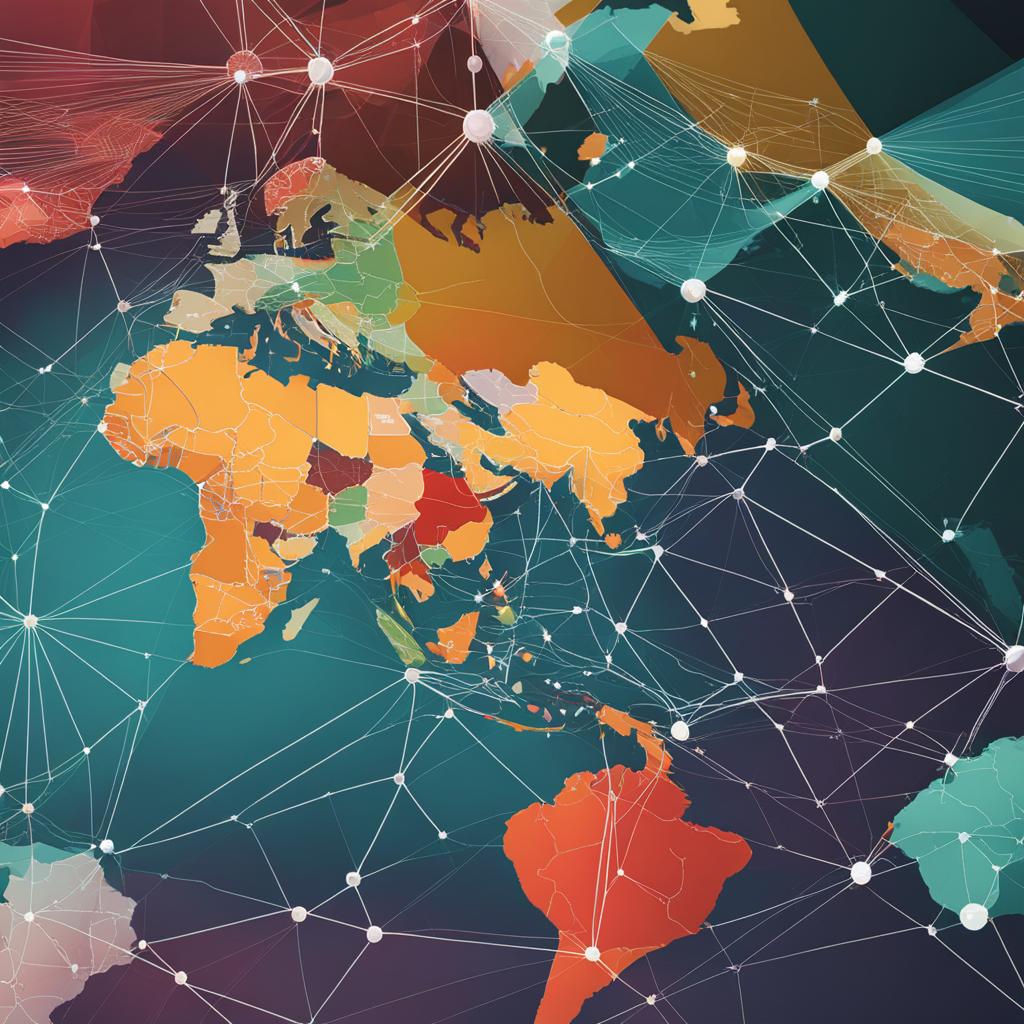Have you ever wondered how the global financial system works? At first glance, it can seem like a labyrinth of numbers, institutions, and markets. But fear not, dear reader, for we are here to guide you through this complex ecosystem.
So, what exactly is the global financial system? It’s the vast network of institutions, regulations, and markets that facilitate the flow of money between countries. From Wall Street to Main Street, from central banks to investment banks, the global financial system is truly a global phenomenon.
In this section, we will explore the intricacies of the global financial system and shed light on its inner workings. Join us as we uncover the complexities and intricacies that drive this vast network of institutions and markets.
Together, we will gain a comprehensive understanding of this remarkable system that shapes the global economy. Let’s discover the secrets of the global financial system, starting with the basics.
Understanding the Global Financial Landscape
As we continue our journey into the inner workings of the global financial system, let’s take a moment to gain a comprehensive overview of this vast network of institutions and markets. The global financial system consists of various entities that interact with each other, influencing the global economy.
Key Players
The key players in the global financial system include:
- Central banks
- Commercial banks
- Investment banks
- Hedge funds
- Insurance companies
- Mutual funds
- Stock exchanges
- Bond markets
- Foreign exchange markets
These players operate in various markets, each with its unique characteristics. Let’s take a closer look at some of the main markets that operate within the global financial system.
Markets
| Market | Description |
|---|---|
| Money Market | A market for short-term debt securities such as treasury bills, commercial paper, and certificates of deposit |
| Bond Market | A market for long-term debt securities such as corporate bonds, municipal bonds, and treasury bonds |
| Stock Market | A market for equity securities such as stocks and shares of publicly traded companies |
| Foreign Exchange Market | A market for exchanging currencies between different countries |
| Commodity Market | A market for trading commodities such as gold, oil, and agricultural products |
These markets are interconnected, and changes in one market can have a ripple effect on others. For example, a rise in interest rates in the bond market can lead to a decrease in demand for stocks in the stock market.
Understanding the global financial landscape and its key players and markets is crucial in comprehending the nuances of this complex system. As we continue to explore the inner workings of the global financial system, let’s keep in mind the intricate connections and interdependence of its components.
The Role of Central Banks in the Global Financial System
In the intricate machinery of the global financial system, central banks play a pivotal role as the lenders of last resort and the guardians of monetary stability.
Central banks are independent institutions that operate under the mandate of governments to manage monetary policy and regulate the supply of money in the economy. Their primary function is to maintain price stability and promote sustainable economic growth through control of inflation and interest rates.
Central banks also supervise and regulate financial institutions, such as banks and insurance companies, to ensure their stability and prevent systemic risks that could destabilize the financial system.
One of the most significant tools that central banks use to achieve their goals is the manipulation of interest rates. By setting the benchmark interest rate, central banks can influence the cost of borrowing and lending, affecting the behavior of consumers, businesses, and financial markets.
Another important role of central banks is to act as a lender of last resort. In times of financial stress or crises, central banks provide liquidity to financial institutions to avoid a credit freeze and potential financial collapse.
Central banks also manage foreign exchange reserves, which are the holdings of foreign currencies and gold that central banks use to stabilize their currencies and intervene in the foreign exchange market.
“In the intricate machinery of the global financial system, central banks play a pivotal role as the lenders of last resort and the guardians of monetary stability.”
The actions of central banks have a significant impact on the global financial system. Changes in central bank policy can have ripple effects across countries and markets, as investors and traders adjust their portfolios and positions.
For example, when the US Federal Reserve increased interest rates in 2018, it triggered a sell-off in emerging market currencies and stocks as investors flocked to the dollar and higher-yielding US assets.
Central bank decisions are closely watched by financial markets and can generate significant volatility in asset prices. In recent years, central banks have faced increasing pressure to manage the risks of financial stability while promoting economic growth.
As we continue to uncover the complexities of the global financial system, it is essential to recognize the critical role that central banks play in ensuring its stability and functionality.
The Global Financial Crisis: Lessons Learned
The global financial crisis of 2008 was a watershed moment for the global financial system, which up until its collapse, was viewed as invincible. The crisis was triggered by a combination of factors, including a housing market bubble, over-leveraged banks, and lax regulation. The resulting domino effect led to the collapse of several large financial institutions, mass unemployment, and a global recession that lasted for several years.
The after-effects of the crisis are still being felt today, with many economies struggling to recover fully. However, there are several lessons that we can learn from this crisis, which can help us build a more resilient and stable financial system:
The Need for Stronger Regulations and Oversight
One of the primary causes of the global financial crisis was the lack of oversight and regulation in the financial sector. Banks and other financial institutions engaged in risky behavior, such as subprime lending and excessive leverage, that was not adequately monitored or regulated. As a result, when the housing bubble burst, it triggered a chain reaction that led to the collapse of several major banks.
Since the crisis, regulators have implemented several reforms that aim to prevent a similar crisis from happening again. For example, the Dodd-Frank Wall Street Reform and Consumer Protection Act increased oversight and regulation of financial institutions, while the Basel III accord imposed stricter capital requirements on banks. However, there is still much work to be done to ensure that the financial system is stable and resilient.
The Importance of Transparency and Accountability
Another key lesson from the crisis is the importance of transparency and accountability in the financial system. The lack of transparency in derivative markets and other financial products meant that investors and regulators did not fully understand the risks involved. Additionally, some financial institutions engaged in unethical or fraudulent behavior, without consequences.
In response, there have been calls for greater transparency and accountability in the financial system. For example, the Securities and Exchange Commission (SEC) has implemented several rules that require increased disclosure and reporting by financial institutions.
The Role of Central Banks
Finally, the crisis highlighted the critical role that central banks play in maintaining the stability of the financial system. In the aftermath of the crisis, central banks around the world implemented measures to stabilize markets and prevent a complete collapse of the financial system. For example, the Federal Reserve cut interest rates to near-zero and implemented massive quantitative easing programs.
However, these measures also had unintended consequences, such as a rise in income inequality and a lack of inflation. As a result, central banks are now re-evaluating their roles in the financial system and exploring new policy tools.
“The global financial crisis was a wake-up call for the financial industry and policymakers alike. While significant strides have been made towards a more stable and resilient financial system, there is still much work to be done. By applying the lessons learned from the crisis, we can build a financial system that is transparent, accountable, and able to withstand future shocks.”
Innovations and Challenges in the Global Financial System
Over the years, the global financial system has witnessed significant changes in the form of innovative technologies and models. These include the use of financial technology, blockchain, and digital currencies, among others. While these innovations have revolutionized the industry, they have also presented new challenges for regulators and policymakers.
The Rise of Financial Technology
Financial technology (Fintech) has transformed the way financial institutions operate and interact with their customers. From mobile banking applications to peer-to-peer lending platforms, Fintech has led to increased convenience, accessibility, and efficiency in financial services. For instance, according to a report by Statista, the global investment in Fintech surpassed $100 billion in 2018, indicating the rapid growth and adoption of these technologies worldwide.
However, the rise of Fintech has also posed new challenges related to data privacy, security, and ethical considerations. With the increasing use of digital platforms, personal data is more vulnerable to cyber attacks and breaches. As a result, regulators and policymakers are now tasked with ensuring the protection of customer information while also promoting innovation in the industry.
The Emergence of Blockchain Technology
Another significant innovation in the global financial system is blockchain technology. This decentralized ledger system has disrupted traditional financial models by enabling secure and transparent transactions without the involvement of intermediaries. Blockchain has the potential to minimize fraud and corruption, increase accountability, and reduce transaction costs.
However, the adoption of blockchain technology has also presented new regulatory and governance challenges. For instance, the lack of standardization in the industry has resulted in varying regulations and policies across different jurisdictions. Additionally, the high-energy consumption associated with blockchain operations has raised concerns about environmental sustainability.
The Advent of Digital Currencies
Digital currencies, such as Bitcoin and Ethereum, have gained popularity in recent years due to their decentralized nature, anonymity, and potential for high returns. The impact of digital currencies on the global financial system is still evolving, as their adoption and regulation remain a subject of debate among policymakers and regulators.
The rise of digital currencies has also presented new challenges related to money laundering, tax evasion, and illicit activities. Governments and financial institutions are now exploring approaches to regulate these currencies while also promoting innovation in the industry.

“The greatest danger in times of turbulence is not the turbulence itself, but to act with yesterday’s logic.” – Peter Drucker
As we continue to witness advancements in the global financial system, it is crucial to stay informed and open to change. While innovations bring new opportunities, they also require us to tackle new challenges and adapt to new regulations and policies.
Conclusion
Our journey through the intricacies of the global financial system has been eye-opening. We have gained insights into how different entities interact and influence the global economy. We explored the pivotal role that central banks play in the global financial system, their functions, responsibilities, and their impact on monetary policy, stability, and economic growth. We also delved into the global financial crisis that shook the world in 2008.
The lessons learned from this event have brought about subsequent reforms that have positively impacted the global financial system. We also discussed the innovations that have shaped the global financial system, such as financial technology, blockchain, and digital currencies.
However, as much as there have been significant advancements, there are still challenges that arise from rapid technological advancements. These challenges include the need for regulatory frameworks to keep pace with the innovations that drive the financial system.
As we continue to navigate the complexities of the global financial system, we must stay informed and open to the changes that shape this ever-evolving ecosystem. Together, we can ensure that the global financial system remains strong, stable, and conducive to the growth and development of economies worldwide, now and in the future.




